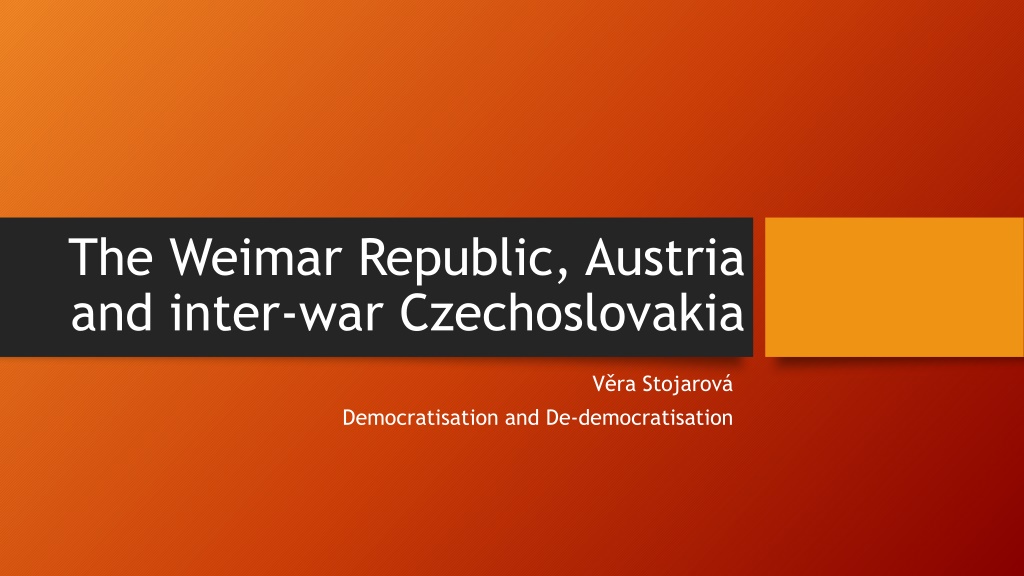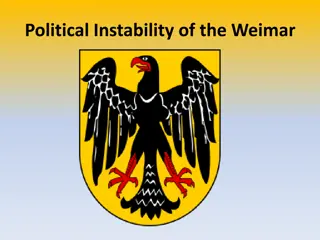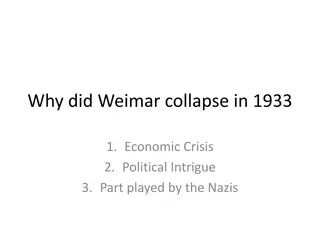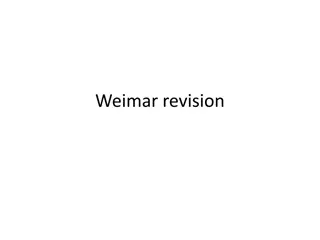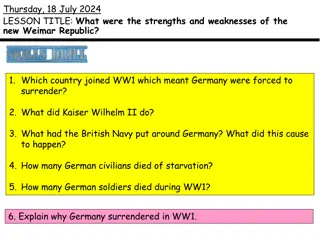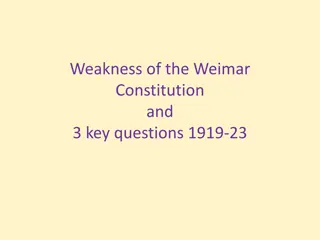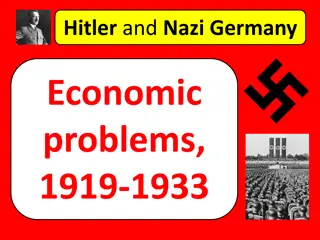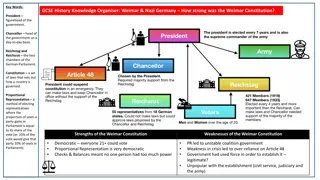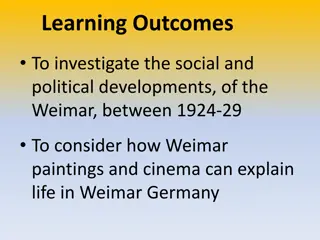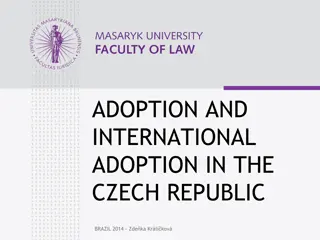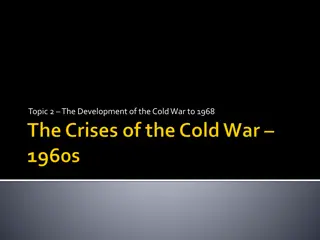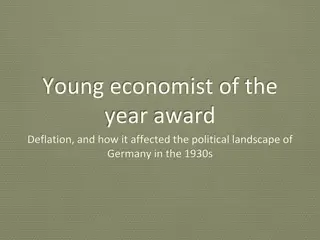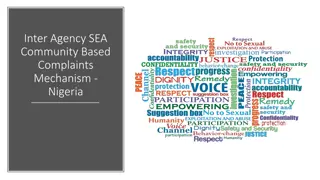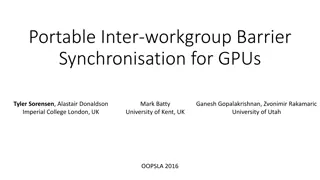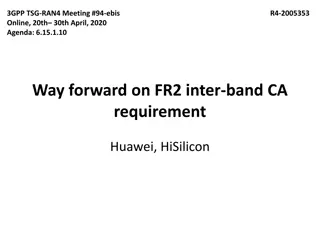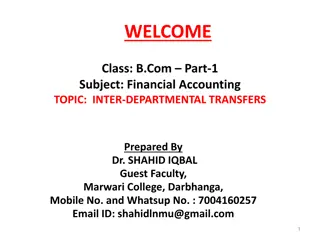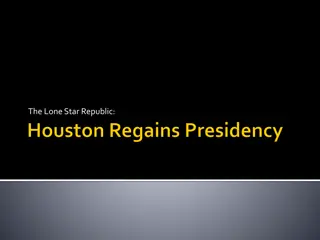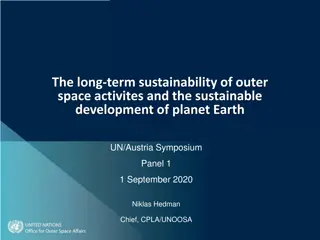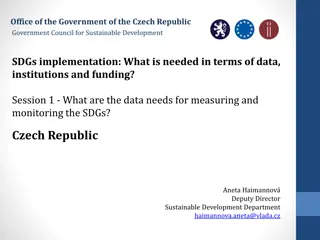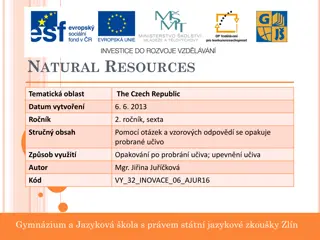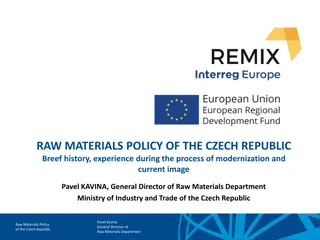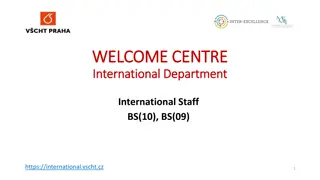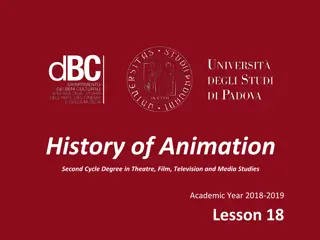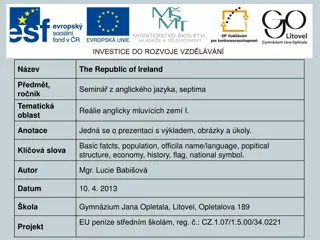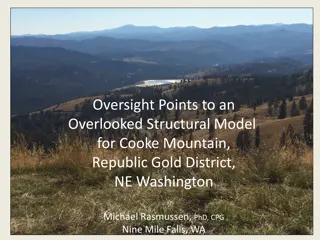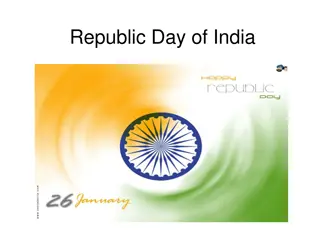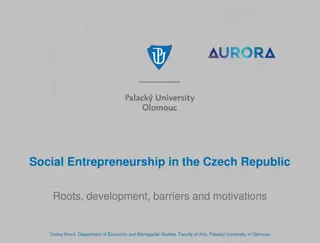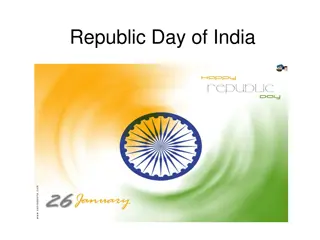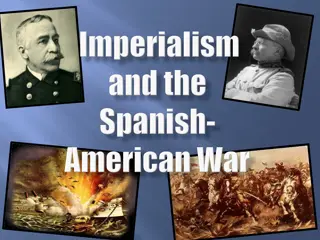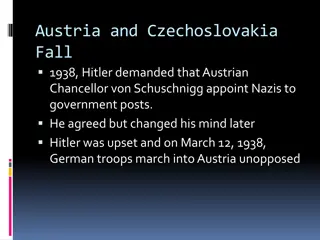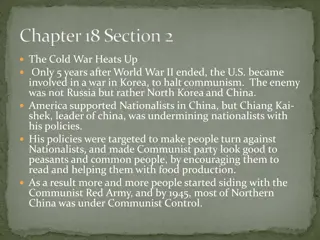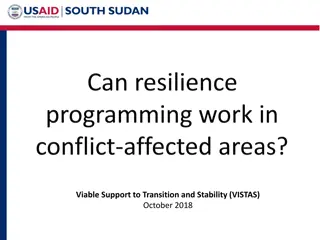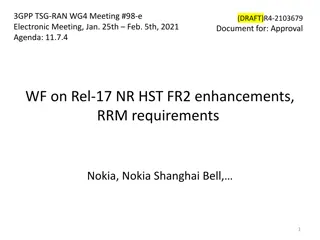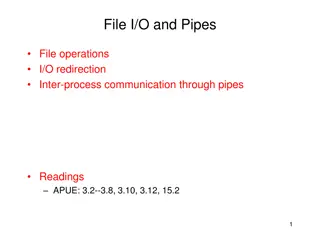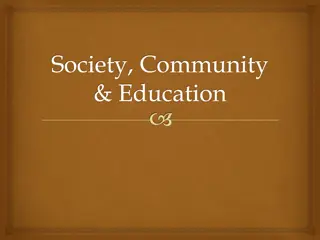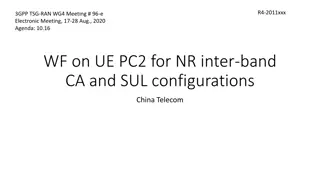Democratisation and De-democratisation: The Weimar Republic, Austria, and Inter-war Czechoslovakia
The period between the World Wars saw the birth of new states like the Weimar Republic, Austria, and Czechoslovakia, each facing unique challenges. From the aftermath of WWI to the Treaty of Versailles and economic crises, these states navigated political extremism, hyperinflation, and territorial concessions. The Weimar Republic, in particular, implemented progressive social policies amidst economic turmoil.
Uploaded on Sep 23, 2024 | 0 Views
Download Presentation

Please find below an Image/Link to download the presentation.
The content on the website is provided AS IS for your information and personal use only. It may not be sold, licensed, or shared on other websites without obtaining consent from the author. Download presentation by click this link. If you encounter any issues during the download, it is possible that the publisher has removed the file from their server.
E N D
Presentation Transcript
The Weimar Republic, Austria and inter-war Czechoslovakia V ra Stojarov Democratisation and De-democratisation
The prelude WWI 1014-1918 The great war over 20 million deaths as direct result of the war plus Spanish flu, resulted in revolutions, uprisings Austro-Hungarian, Russian, Ottoman and German empires ceased to exist Numerous states created Paris Peace Conference League of Nations created
Warming- up It s 1918 you are about to create Czechoslovakia/Austria/Weimar republic what do you have to do? What do you have to deal with? What are the challenges for the new states?
Treaty of Versailles required Germany to disarm (army of no more than 100,000 men in a maximum of seven infantry and three cavalry divisions. make ample territorial concessions Colonies transfer and pay reparations In 1921 the total cost of these reparations was assessed at 132 billion gold marks (then $31.4 billion or 6.6 billion, roughly equivalent to US$442 billion in 2021). Renegotiations, postponement Cause of WWII?? https://www.bbc.co.uk/bitesize/guides/z9y64j6/revision/3 (Treaty of Versailles 30 sec, excerpt)
Weimar Republic 1918-1933 German exhausted Proclamation of republic and abdication of the monarch Hyperinflation Political extremism Paramilitaries to fill in the gap after the army Issues with neighbours Golden 1920 s and then decline Economic crisis 1929
Progressive Social policies under Weimar maximum working 48-hour workweek restrictions on night work a half-holiday on Saturday, and a break of thirty-six hours of continuous rest during the week. health insurance was extended to wives and daughters without their own income, people only partially capable of gainful employment, people employed in private cooperatives, and people employed in public cooperatives. progressive tax reforms all aid for the disabled and their dependents be taken over by the central Unnemployment benefits Health insurance State responsibility, welfare system
Under attack of left and right-wing Freikorps Spartacist uprising 1919 between moderate and radical left (Fridrich Ebert social democrats vs. Karl Liebknecht and Rosa Luxembourg communists) 1920 Bavarian Soviet Republic 1923 Munich poutsch (Beer Hall Putsch) Hitler in jail writing Mein Kampf, re-thinking means how to gain power (https://www.youtube.com/watch?v=pJVQZWLqSPE&list=PLu2xst_ eS6dqU4NGf92ipWZ2jnvPmXnV8&index=11 10 min)
The 1930s Hyperinflation Unemployment NSDAP entered parliament 1930 Chancellors ruling by decrees without the parliament https://www.youtube.com/watch?v=vO-_HXO7HwY (10 minutes Weimar republic) 1932 July elections (NSDAP 37%, SDP 21%, Communists 14%) no coalition government with a majority could be formed 1932 November elections (33% NSDAP, 20% SDP, communists 16%) last free elections, Hitler forms government 1933 elections suppression of communists and SD
Seizure of control 1930-33) Nazi Propaganda and the power of radio (https://www.youtube.com/watch?v=aD6zpu0H6d4 6 min)
1933 end of Weimar Republic Meetings of the left-wing parties were banned and even some of the moderate parties found their members threatened opposition. suppressed the Communist Party arrests of Reichstag deputies. The Reichstag fire on 27 February was blamed by Hitler's government on the Communists. state of emergency Reichstag Fire Decree - The decree invoked Article 48 of the Weimar Constitution and "indefinitely suspended" a number of constitutional protections of civil liberties, allowing the Nazi government to take swift action against political meetings, arresting and killing the Communists. State broadcasting exploited by NSDAP 1933 elections (NSDAP 43%, SD 18%, Communists 12, Center 11%) NSDAP monitoring the voting proces
Mein Kampf process by which Hitler became antisemitic and outlines his political ideology and future plans for Germany the Jewish peril", which posits a Jewish conspiracy to gain world leadership he world's two evils: Communism and Judaism. his ambitions for creating a New Order. Hitler saw a purpose in destroying "the weak" in order to provide the proper space and purity for the "strong Lebensraum the Jews and "Bolsheviks" as racially and ideologically inferior and unification of German peoples into one Greater Germany.
Power of propaganda Voelkischer Beobachter, Angriff Public meetings speeches by Hitler Ministry for propaganda The KdFwas created to monitor what workers were doing in their non-working time. The KdF also monitored holidays and all leisure time by scheduling activities for workers This produced support for the state from the working class which led to Nazi Germany's further rise in power. The KdF required members to participate in the activities offered to them, otherwise, any members who didn't participate were classified as anti- government. being sent to a concentration camp as punishment. Textbooks for schools, jewish authors banned, textbooks for occupied territories Newspapers, film posters
Austria between WWI and WWII - Republic of German Austria/First Austrian Republic 1919 - Left/right violent politics - Paramilitary clashes (Republikanischer Schutzbund of SD and nationalist Heimwehr - Conservative countryside vs. social democrats in Red Vienna
Constitution Parliamentary democracy strong parliament , 2 chambers Executive power in the hands of chancellor nominated by the parliament Relatively weak president elected by both houses as a head of state
The July revolt of 1927 Vienna Palace of Justice fire major riot It culminated with police forces firing into the outraged crowd, killing 89 protesters, more than 600 protestors and around 600 policemen were injured. Clash as a result of left/right clashes
Towards authoritarianism In 1929 constitutional revision more powers for the president President elected by the people The president was also to be vested with the authority to dissolve the parliament, a power typically not held by heads of executive branches of parliamentary republics. He also had the authority to formally appoint the chancellor and the cabinet. towards a system concentrating power in the hands of president was made in an attempt to appease the para-fascist movements In 1934, authoritarian corporate state 1938 Austria was annexed by Nazi Germany
Economy Barely able to provide food for its citizens The great depression
Austrian civil war - 1934 Austrian Nazi party wanted Austria to join Germany. Competition to Roman Catholicism as a means to show the reason why Austria should not join a predominantly Protestant Germany. War between Nazis, Social Democrats and government forces. On 1 May 1934, Dollfuss created a one-party state, to be led by the Fatherland Front Federalism and the controlling powers of the Federal Council was curtailed elections for the National Council was abolished its members nominated by four non-elective, corporatist-styled councils all legislation and appointments were exercised from above by the Federal Chancellor's and President's decree.
1934-38 Dictatorship The Nazis assassinating Engelbert Dollfuss during the July Putsch of 25 July 1934 The successor to Dollfuss, Kurt Schuschnigg, maintained the ban on Nazi activities, banned the Heimwehr in 1936. Anschluss
Anschluss Paris Treaties had explicitly forbidden the unification of Austria and Germany On 12 March, German troops entered Austria, who met celebrating crowds, in order to install Nazi puppet Arthur Seyss-Inquart as Chancellor. With a Nazi administration integrated into the Third Reich and renamed as "Ostmark" until 1942, when it was renamed A rigged referendum on 10 April was used to demonstrate the alleged approval of the annexation with a majority of 99.73% for the annexation. The Jews, Communists, Socialist and hostile politicians were sent to concentration camps
Inter war Czechoslovakia First republic 1918-1938 Second Republic 1938-39 After 1933 Czechoslovakia was left the only democracy in central and Eastern europe
Constitution parliamentary democracy 2 chambers universal suffrage The National Assembly was responsible for legislative initiative and was given supervisory control over the executive and judiciary as well. Every seven years it elected the president and confirmed the cabinet appointed by him. Executive power was to be shared by the president and the cabinet; the latter, responsible to the National Assembly The reality differed somewhat from this ideal - strong presidencies of Masaryk and his successor, Bene
2nd Republic Munich Agreement 30.3.1938 UK, Fr, It, Ger, Sudetenland major natural obstacle to any possible German attack. Sudetenland was of absolute strategic importance to Czechoslovakia. Hungarian attempts to revise borders Slovak strive for independency, Subcarpathian Ruthenia for autonomy Secrets meetings with Slovak politicians with Hitler Political system in chaos, Communist party dissolved
This is the end 14th March independent Slovakia (if you do not declare independency we will leave you to the Hungarian and Polish hords) 15th March 1939 occupation, protectorate of Bohemia and Moravia Hungarian occupation of carpatho-ruthenia Foreign agression, ethnic tensions, internal political tensions WWII
Seminar Its 1918 you are about to create Czechoslovakia/Austria/Weimar republic what do you have to do?
Weimar Republic, Austria, Czechoslovakia Political transformation from monarchy to republic, design of the political system, what shall we do with monarchs? Foreign policy? Do we have enough of capable cadres? Design of the electoral system (from majority to proportional?), who shall have the right to vote, to be elected (those who can read and write?, who have property, soldiers, mentally disabled???) accomodation of nations (centralisation/decentralisation), debts of Austria/Hungary and successor states, state borders, currency, flag, coat of arms, war reparations paid by Czechoslovakia though being victorious state, Social transformation what shall we do with the feudals? Women and the suffrage? Women and work? Accomodation of women, minorities, cleavage city/village, abolition of censorship and flourishing of media, radio, cinema, war reconciliation, collaboration, land reform, division of the church from the state, emergence of new churches Economy capitalism? Socialism? Welfare state? Health system? Unemployment benefits? New borders within austria/hungary leading to protectionism of the agricultural products
Factors influencing the prosperity and stability of the state?
Factors of prosperity and stability The geographical position The region and the history The political system The population and ethnic structure The language, religion and culture The symbols of the state The size and density of population The urban versus rural percentage The wealth of the state The interaction and intermarriages
Seminar Construct totalitarian state (in terms of geography, politics, economic, symbols, religion, language, culture, etc. Elect leader and write his inauguration speech
Seminar Transitional justice International tribunals (nurnberg, tokio) Reparations (concept, case studies)
